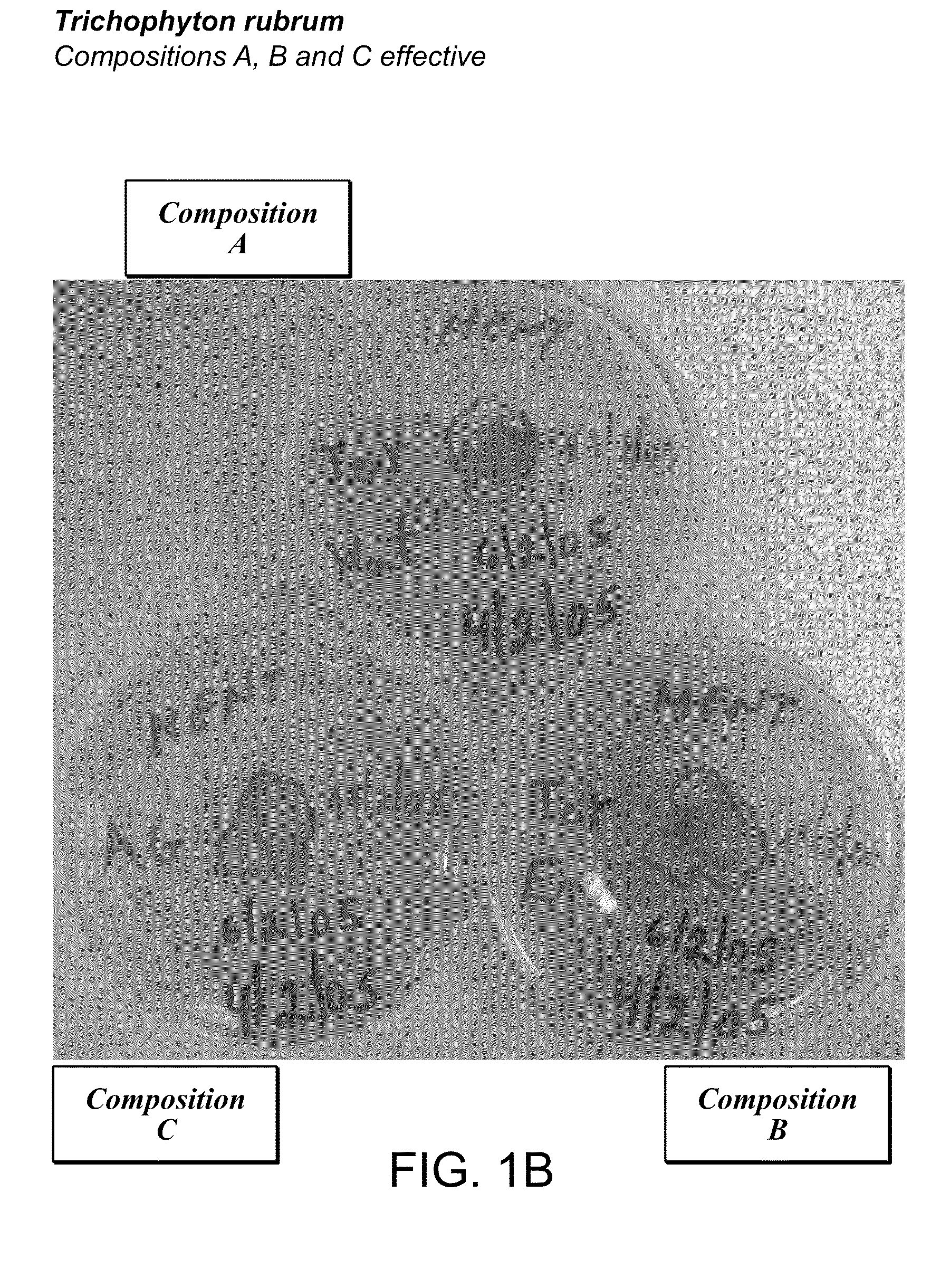Foamable vehicle and pharmaceutical compositions thereof
a technology of foaming and pharmaceuticals, applied in the direction of drug compositions, antibacterial agents, aerosol delivery, etc., can solve the problems of reducing the efficacy of drugs, and affecting the normal respiration of skin
- Summary
- Abstract
- Description
- Claims
- Application Information
AI Technical Summary
Problems solved by technology
Method used
Image
Examples
example 1
Foamable Carriers Containing Polyols
[0187]
TECH PG-014TECH PG-015TECH PG-016Ingredient% W / W% W / W% W / WPropylene glycol (PG)82.0092.0060.00Laureth-42.002.002.00Glyceryl stearate and PEG-1004.004.003.00stearate (Simulsol 165)PEG 400010.00Glycerin anhydrous33.00Hydroxypropylcellulose (Klucel EF)2.002.002.00Total100.00100.00100.00Foam qualityGoodGoodGoodShakabilityShakableShakableShakable
[0188]Notes:[0189]The compositions are substantially non-aqueous[0190]Composition TECH PG-015 contains the minimum number of components that constitute a foamable composition, which upon release from an aerosol pressurized container affords foam of Good or Excellent quality. It contains a diol (PG), a polymeric agent (Klucel EF), and a non-ionic surface active agent (PEG-100 stearate and Laureth 4)[0191]Composition TECH PG-014 demonstrates that the addition of 10% PEG (secondary polar solvent) maintains Good foam quality.[0192]Composition TECH PG-016 demonstrates that a mixture of two polyols (PG and glyc...
example 2
Foamable Carriers Containing Polyols
[0194]
TECH PG-021TECH PG-024TECH PG-025Ingredient% W / W% W / W% W / WPropylene glycol (PG)91.0058.0043.00Stearyl alcohol2.001.001.00Laureth-42.002.002.00Glyceryl stearate and PEG-1003.003.003.00stearate (Simulsol 165)Glycerin33.0033.00Hydroxypropylcellulose (Klucel EF)2.003.003.00Dimethyl isosorbide (DMI)15.00Total100.00100.00100.00Foam qualityExcellentExcellentExcellentShakabilityShakableShakableShakable
[0195]The following procedure was employed when the compositions of Example 2 were produced.
Step 1: Preparation of Phase A
[0196]1. Heat Propylene glycol and stearyl alcohol to 80-85° C.[0197]2. Add Klucel while mixing.[0198]3. Cool to 70-75° C. Addall other ingredients while mixing. Agitation continues until solution uniformity is reached[0199]4. Cool solution to 30° C. whith moderate mixing.
Step 2: Canisters Filling and Crimping[0200]1. Each aerosol canister 35×70 mm is filled with 30±5% g of the composition[0201]2. Each canister was closed with an ae...
example 3
Foamable Carriers Containing Polyols
[0206]
TECH PG-026TECH PG-027TECH PG-028Ingredient% W / W% W / W% W / WStearyl alcohol2.001.001.00Propylene glycol (PG)76.0046.0078.00Laureth-42.002.002.00Glyceryl stearate (and) PEG-1001.50stearate (Simulsol 165)Glycerin anhydrous33.00Hydroxypropylcellulose (Klucel EF)2.001.501.50Dimethyl isosorbide (DMI)15.0015.0015.00Glyceryl stearate1.001.00Ceteareth-6 (and) stearyl alcohol2.001.50(Macrogol cetostearyl ether)Total100.00100.00100.00Foam qualityExcellentExcellentExcellent
[0207]Notes:[0208]Composition TECH PG-027 demonstrates that a mixture of two polyols (PG and glycerin, plus DMI (secondary polar solvent) maintains Exellent foam quality. This composition possesses high skin hydration effect. It further possesses high skin penetration enhancing properties.[0209]The liquefied or gas propellant can be added at a concentration of about 3% to about 25%.
PUM
| Property | Measurement | Unit |
|---|---|---|
| Ozone Depletion Potential | aaaaa | aaaaa |
| concentration | aaaaa | aaaaa |
| hygroscopic | aaaaa | aaaaa |
Abstract
Description
Claims
Application Information
 Login to View More
Login to View More - R&D
- Intellectual Property
- Life Sciences
- Materials
- Tech Scout
- Unparalleled Data Quality
- Higher Quality Content
- 60% Fewer Hallucinations
Browse by: Latest US Patents, China's latest patents, Technical Efficacy Thesaurus, Application Domain, Technology Topic, Popular Technical Reports.
© 2025 PatSnap. All rights reserved.Legal|Privacy policy|Modern Slavery Act Transparency Statement|Sitemap|About US| Contact US: help@patsnap.com



